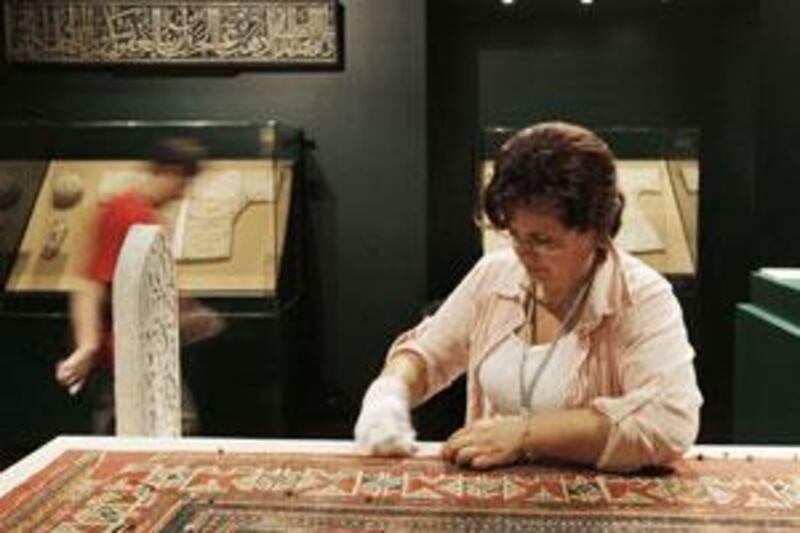ABU DHABI // The Islamic artefacts are rare and breathtaking: the sword of Muawiyah from the Umayyad Caliphate; an embroidered Kaaba curtain that has not been moved in centuries; even a replica of the Prophet Mohammed's footprint. All are being shown for the first time in Abu Dhabi, and many are making their first trip outside Turkey. The exhibition, which opens today at the Emirates Palace hotel, features 161 pieces, most of which are from the Topkapi Palace Museum and the Turkish and Islamic Arts museum, both in Istanbul. Organisers said they took an unprecedented approach to displaying the objects, presenting them as part of a "storyline" that encompassed many aspects of faith. "The design of the exhibition started with the storyline, and then the objects were fitted into the storyline - were chosen to support the storyline," said Dr Sami el Masri, deputy director for arts, culture and heritage at the Abu Dhabi Authority for Culture and Heritage (Adach). "We're moving away from the sterile presentation of art objects, which obviously don't give you the full picture. "We chose the pieces through a committee of curators and followed not only the story of Prophet Mohammed but of many aspects of faith and worship in Islam." Islam: Faith and Worship is the product of an agreement signed between Turkey and Abu Dhabi last July to promote the sharing of cultural resources. The agreement particularly targeted resources concerning Islamic heritage. "Presenting Islamic objects of faith in the context of exhibition that focuses on Islam and its practice is an unprecedented case," said Orhan Duzgun, director general for cultural heritage and museums in Istanbul. The collection includes carpets, paintings, weapons, garments and the replica of a footprint of the Prophet, which are on loan from seven of Turkey's most respected museums. It is the first time one piece, an intricately embroidered Kaaba curtain, has been allowed out of the Topkapi Palace in almost 200 years. The exhibition is laid out in nine areas in Gallery One in the Emirates Palace hotel. Each area has a different theme. The first room, dedicated to God, has Arabic calligraphy on the walls and features a kundum drum from the 15th century, while the second room includes Ottoman figurative art telling the stories of the prophets. The Prophet Mohammed's footprint is depicted in silver. Other rooms are dedicated to worship and faith, displaying intricate Quran holders and covers, as well as prayer rugs from the 1600s and gold-threaded ablution towels from the 19th century. The final rooms focus on symbolism and the holy pilgrimage to Mecca and Medina. Included in the display are 16th-century gold locks and keys from the Kaaba and an embroidered door hanging from the sacred site used in 1790. Dr Huyla Tezcan, the curator, said the pieces were chosen to "emphasise symbolism and infinity in Islam". "We wanted to give all the visitors an idea of the Islamic philosophies," she said. "It is a fluid story. It begins and ends with Allah. The symbols and objects we have chosen also show a deep respect for the Prophet Mohammed." Dr el Masri added that the timing of the show was important. "It should be noted that the exhibition will be shown throughout the holy month of Ramadan," Dr el Masri said. "This is intentional; we want to put the show in context for all viewers." Mohammed Khalaf al Mazrouei, the director general of Adach, said: "This exhibition represents [Abu Dhabi's] high standards and is a witness to the UAE's continued sponsorship of art and culture." Islam: Faith and Worship is open from every day 9am to 7pm. In Ramadan the hours will be from 10am-1pm and from 8-10pm. aseaman@thenational.ae
Weaving art and history into 'storyline' of Islam
Many Islamic artefacts on show in Abu Dhabi are making their first trip outside Turkey.

Editor's picks
More from the national





